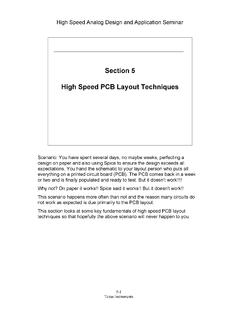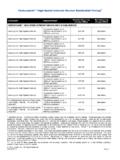Transcription of High Speed,Real-Time Machine Vision
1 high speed , real - time Machine VisionPerry West Automated Vision Systems, of The Stimulus ..5 External Sensor ..5 Part Detection Through Imaging ..6 Image Acquisition ..6 The Role of the Camera ..6 The Role of the Frame speed ..20 Instruction Set ..21 Software Development ..21 Single Processor ..21 Multi-Processor ..22 Operating System ..23 Application ..24 Latency time ..26 Video Transfer ..27 Transfer to CPU ..27 Image ..27 time Activation ..28 Example Requirements ..29 Design ..29 Latency Requirements ..31 Initial Design ..31 Solving the Uncertainty in Part Position ..33 Solving the Image Blur and Motion Tear Problems ..33 Number of Cameras ..34 Frame Grabber.
2 System ..36 Application Operation ..36 Summary ..37 List of FiguresFigure 1 Value Functions for Soft and Hard real - time ..1 Figure 2 Event A ..4 Figure 3 Event B ..4 Figure 4 Events A & B Combined ..4 Figure 5 Event C ..4 Figure 6 Events A, B, & C 7 Simplistic CCTV Timing ..7 Figure 8 Basic CCTV Image Acquisition 9 Interlace 10 Interlace 11 Motion Tear ..9 Figure 12 Progressive Scan Camera Timing ..9 Figure 13 Asynchronous Camera Timing ..11 Figure 14 Asynchronously Resettable Camera 15 Camera Timing with Strobe Illumination ..13 Figure 16 Camera Timing with Electronic Shutter ..14 Figure 17 Basic Frame Grabber ..15 Figure 18 Simple Frame Grabber System 19 Frame Grabber with Ping-Pong 20 Ping-Pong Frame Grabber System Timing.
3 16 Figure 21 PCI Bus Transfer 22 Single 23 Common Multi-Processor Approach ..22 Figure 24 Inspecting 25 Dual Camera Configuration ..35 List of TablesTable 1 Adding Up 2 Latency Compilation Template ..26 Table 3 Latencies for Example 4 Initial Compilation of Latencies, Example 5 Final Latencies for Example widget moves along a continuously moving conveyor belt, trips a sensor, the Vision system performs itsinspection, and operates an ejector to remove a defective widget all at high speed and in real - time . So,exactly what is high - speed , what is real - time ` and what is the difference? high - speed has no formal definition. To most people it means a very short time elapses between thecommand to take an image and the Vision system s output.
4 A better meaning for high - speed is that thevision system can take in image data at a high rate continuously. That is, it can acquire and processimages at a high rate (frames per second). Another meaning of high - speed sometimes used in industrialmachine Vision is that the Machine Vision system is always much faster than any other process step thatlimits the manufacturing line speed . A final use for the term high - speed relates to its ability to imageproducts that are moving at rates that can cause significant image blurring. What these definitions don ttell us is what rate sets the threshold for a high - speed Vision system. There is no technical definition ofhigh- speed such as 10 images/second.
5 The implication, though, is that a high - speed system is one that canoperate faster or have a higher data rate than ordinary , on the other hand, doesn t necessarily mean really fast. It does mean the system will be timely the results will be provided when they are needed. A Vision system s timeliness can be viewed as a valuefunction. In a typical Machine Vision application where the part stops for viewing and is not advanced untilthe Vision system has made its decision, there is some value to the Vision system making a decision by acertain time so that it is not the slowest element of the production process. If the Vision system is earlierthan this time , its value is not increased because the production line cannot go any faster.
6 If the visionsystem is almost always on time , but very occasionally a little slower, its value might be diminished onlyslightly. However, as the Vision system becomes slower on average or more frequently, it becomes abottleneck, and its value declines eventually becoming negative. Such a system would be called soft the example in the first paragraph above of a widget on a continuously moving conveyor, the valuefunction is high only when the reject decision is output while the widget is passing next to the ejector. Ifthe Vision system is either too early or too late, its value is negative. This system would be called hard 1 below shows value functions for soft and hard 1 Value Functions for Soft and Hard real -Time2In the example at the beginning the widget tripping the sensor is the event and the Vision system s decisionto operate or not operate an ejector is the response.
7 In technical terms the time between an event and aresponse to that event is the latency. The important characteristic in a real - time system is that latency isdeterministic. That is, the response will always happen at a predictable time after the requirements for a system s speed and the determinism of its latency greatly affect the engineeringchallenges in developing the system. The key to achieving high - speed is understanding how to combinesystem components to get the best throughput. The key to achieving real - time performance isunderstanding and managing high - speed and real - time are technically different criteria, they are most often found paper focuses more on real - time issues with discussions about how to achieve high -speedperformance.
8 The paper starts with a description of latency and then focuses on high - speed and real -timeissues in two areas: imaging and image processing. Finally, this paper looks at two examples anddiscusses how the systems can be engineered to meet requirements. These examples are composites ofreal-world Machine Vision systems. In that regard they represent real engineering challenges that have beenfaced and met. The examples do not show the complete development of a Vision system. A comprehensivedesign might affect the choices illustrated in the thanks go to the following people who provided input and discussion on the topics covered in thiswhite paper: Duke Bettis, Coleman Gormly, Allan Jackson, Brian Smithgall, Keith Vasilakes, and is the time between an activity s initiation and its result.
9 While a system has an overall activity,from trigger event to output signal, the system itself is comprised of a number of internal events usuallyoccurring serially. Each latency in the system has some degree of uncertainty ranging, in our technology,from a few nanoseconds to several seconds. A system s latency is comprised of the latencies of theindividual processes within the system. In the example shown graphically below in Figure 2 throughFigure 6, there are three serial events A, B, and C, each with its own latency and uncertainty. The latencyis shown as a probability function for the time the event will complete. If we know the probabilityfunctions for the latencies, we can combine them by convolving their probability functions together , in real - time systems, the designer is usually not faced with convolving the latencies the total latency and its minimum and maximum from the individual latencies is the example below:LatencyEventMinimumMaximumA3 12B8 57C17 35 Total28104 Table 1 Adding Up LatenciesNote that in designing a real - time system, typical latency is not meaningful unless the variation in latency isnegligible in comparison to the timeliness required.
10 Following sections will discuss how to minimizelatency and its variation for different parts of the Machine Vision process and how to reduce the variation inlatency by resynchronizing the data flow. Resynchronization is a form of pipelining which removes thevariation in latency by using a time 20406080100 time IntervalProbability of EventFigure 2 Event 20406080100 time IntervalProbability of EventFigure 3 Event 20406080100 time IntervalProbability of EventFigure 4 Events A & B 20406080100 time IntervalProbability of EventFigure 5 Event 20406080100 time IntervalProbability of EventFigure 6 Events A, B, & C Combined5 ImagingThere are three major elements to real - time imaging.





